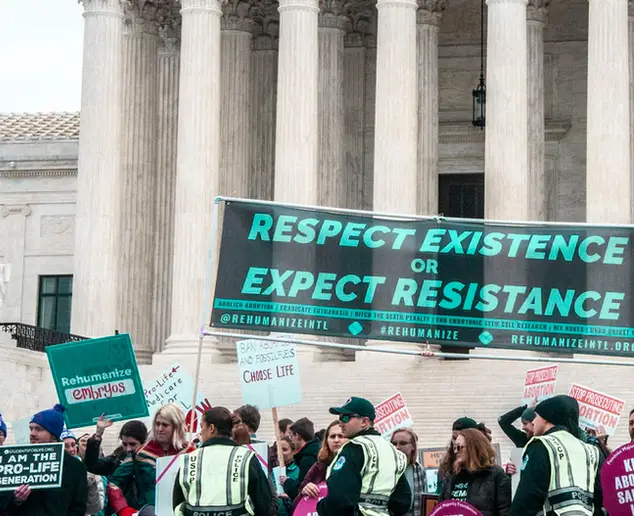The relationship between the pro-life community and vaccines has always been uneasy. Concerns over the use of an aborted fetus in vaccine development continue to trouble those in the community.
This concern has once again arisen in light of the recent, super-charged efforts to develop a Covid-19 vaccine amidst the ongoing pandemic.
With a lot of false information swirling around and questions being asked by those in the community, we have rounded-up all of the relevant pieces of information surrounding aborted fetuses and the Covid-19 vaccine.
Various vaccines have used different techniques, unfortunately, most of which are related to abortion. But there is further detail to go into, and many will not cause ethical concerns for those who identify as pro-life.
Embed from Getty ImagesCovid-19 Vaccines
Ever since the global Covid-19 pandemic hit us, scientists and researchers all around the world have put in extraordinary levels of time and resources into trying to create a vaccine.
While the overall survival rate for those who contract Covid-19 remains very high, the pandemic has caused economic ruin for many countries, has ruined many people’s lives, and continues to disrupt the day-to-day life of so many.
But towards the end of 2020, a range of vaccines were approved. A collaboration between AstraZeneca and Oxford University and a vaccine from Pfizer and BioNtech were approved for use in the United Kingdom – the first western country to do so.
Russia’s Sputnik vaccine, as well as American vaccines from Pfizer-BioNtech and Moderna – have also since received approval from various nations. More vaccines are likely to be approved in forthcoming months, with over 100 already in trials.
But the process of which these vaccines have been created is what has caused concern for those in the pro-life community. Vaccines being reliant on aborted fetuses is nothing new and some Covid-19 vaccines have been based on research emanating from aborted fetuses.
How do vaccines use aborted fetuses?
Unfortunately, vaccines are linked to fetuses. Aborted fetuses from the 1960s and 1970s continue to have an impact on modern-day medicine.
A certain strand of cells, called the HEK-293 cell line, were selected due to being, as Snopes’ Alex Kasprak explains – “uniquely capable of rapidly multiplying modified adenoviruses”. In english, this translates to this particular cell line being able to be replicated for further use among humans.
The HEK-293 cell line originates from a child that was aborted in 1973 in the Netherlands. HEK-293 stands for Human Embryonic Kidney cells.
While we should state that abortion was legal in the Netherlands at the time, there is no getting away from the fact that the child was murdered in the name of abortion.
The child was not aborted for the utilitarian purpose of providing good for humanity. Instead, it was used after the abortion as a means of researching cancer, only to then be used for vaccine research.
The fetus’s cells were used in an attempt to create a “colony” of cells – as explained by Snopes’ Alex Kaspas – for scientific use. They eventually did grow into a viable colony of cells. This is a central concern for those in the pro-life community.
Embed from Getty ImagesSo do vaccines contain cells of aborted fetuses?
This is where things can become a bit difficult. Because of the time difference between 1973 and the modern-day, the cells used to this day are “distant descendants” of the original cells, as explained by Associate Professor Helen Petousis-Harris.
Over the last few decades, the cells that originated from the aborted fetus in 1973 have been cloned and replicated many times over – hence why they were called “distant descendants” by Professor Petousis-Harris.
So while in this day and age the cells used are not distinctly from the aborted fetus, they are related to it. These cells have helped in the creation of vaccines for conditions such as Rubella, Measles and chickenpox.
The above vaccines used cell lines that emanated from an aborted female fetus from 1964 and an aborted male fetus from 1966. But not all vaccines make use of the HEK-293 cells. This is something crucial when considering the Covid-19 vaccines.
So do the Covid-19 vaccines contain cells of aborted fetuses?
So this is where things get a bit more complicated, as the Covid-19 vaccines have generally been created in two different ways, one of which is linked to the aborted fetus firmly, while the other in a very minor fashion.
These two methods are known as the mRNA approach and an alternative, more classic approach of using the HEK-293 cell line. It is the vaccines that use the HEK-293 cell that have caused the most debate among those in the pro-life community.
What is the HEK-293 cell approach?
As alluded to above, the HEK-293 cell approach to vaccines use the aforementioned cell line to manufacture its vaccine.
This approach uses genetic code that is then altered to the Covid-19 virus, a process that eventually results in the human body producing a spike protein that trains the immune system to fight against Covid-19.
Viruses are grown in aborted fetal cell lines in this method.
This genetically modified approach ends with a modified virus. While at this stage there aren’t any concerns, it is what happens next that has proven controversial.
The HEK-293 cells are then used as a means to rapidly multiply this modified virus. The engineered virus is grown in the HEK-293 cells
Which Covid-19 vaccines use the HEK-293 cell approach?
The vaccine that has caused the most debate due to its heavy reliance on the HEK-293 cell line is the Oxford University and AstraZeneca collaboration.
In something which is a further concern to those in the pro-life community, the Oxford/AstraZeneca vaccine used another cell line from an aborted fetus during its testing phase. This is the MRC-5 cell line.
Vaccines from Janssen (a subsidiary of Johnson & Johnson that uses cells from an 18-week-old fetus aborted in 1985), ImmunityBio/NantKwest and CanSino Biologics/Beijing Institute of Biotechnology are all other vaccines that make use of cells from aborted fetuses.
The Russian Sputnik vaccine, which has been met with skepticism in the western world, also uses the HEK-293 cell line. Many China-based vaccines also use this, or other related, cell lines.
Embed from Getty ImagesWhat is the mRNA approach?
The mRNA approach uses a synthetic approach, that doesn’t specifically and physically use the HEK-293 cell. However, the cells were used as part of the design phase of the manufacturing.
Crucially though, no physical cells were used. Instead, the mRNA vaccine approach involves a DNA template being produced in a laboratory, which is then synthetically produced using complex software.
The “m” in mRNA stands for messenger, with RNA being “ribonucleic acid” that essentially means information about an acid sequence can be carried for the aim of creating a protein that is found in the Covid-19 virus.
This protein is crucial, as it then trains the immune system to create the antibodies that can attack Covid-19, should a person become exposed to the virus.
Which Covid-19 vaccines use the mRNA approach?
The two most renowned vaccines that use the mRNA approach are the Moderna vaccine and the Pfizer/BioNTech effort. Both have completed trials, and millions of doses have been ordered from nations around the world.
Others to look out for in the forthcoming months include vaccines from Germany’s CureVac, Sanofi/Protein Sciences and Arcturucs Therapeutics’ efforts, though these could be several months away.
Embed from Getty ImagesWhat does The Pope and Vatican City say about the Covid-19 vaccine
Catholicism and vaccines is another uneasy relationship. Catholics are staunch opponents of abortion and as such, are among the groups most concerned about the Covid-19 vaccines.
The most relevant news in this respect is that in 2005, the Vatican’s Pontifical Academy for Life issued guidance on vaccines.
This guidance stated that Catholics are permitted to receive vaccines using historical fetal cell, as long as there is no reasonable alternative. This was reaffirmed in 2017 by the academy.
A tweet from the Pontifical Academy for Life in November 2020 stated that they found “nothing morally prohibitive with the vaccines developed” by Moderna or Pfizer. This stance was backed up by the pro-life Susan B. Anthony organisation.
However, Dr. Stacy Transancos argued otherwise, stating in an opinion piece on the National Catholic Register’s website, that vaccines that even have a remotely minor connection to aborted fetuses were “ethically uncontroversial”.
She urged her fellow Catholics to look at the bigger picture, and to “speak up loudly with clarity and courage” regarding the ethics involved with using aborted fetuses in medical research.
The above arguments generally hold true for other Christian denominations that adopt pro-life approaches to abortion. It also applies to any individual person or religion that values the sanctity of life.
Overall Conclusion
As covered in this article, there is a very complex relationship between the pro-life community and vaccines.
Crucially, it is important to note that vaccines that used HEK-293 cells do not specifically “contain” the cells of an aborted fetus. However, there is no doubting that the cells of an aborted fetus play a significant role in the vaccine.
Fortunately, the synethic or mRNA approach as it’s known, does not physically use cells from an aborted fetus. As such, it appears to be very reasonable for those in the pro-life community to, in good-conscience, receive a vaccine that uses the mRNA approach.
While the early stages of the mRNA vaccines do involve research conducted on an aborted fetus and confirmatory tests do use HEK-293, there is a very real difference between “design”, “production” and “confirmation”.
As stated, mRNA vaccines do not use physical cells originating from aborted fetuses. So while aborted fetuses do play a role in the design and confirmation stages, crucially, they don’t in the production phase.
What arguably poses the biggest issue though, is that it isn’t possible at this stage to choose which vaccine you want to receive. This is something unlikely to change, but one that poses many problems for those who object to any vaccine that used physical HEK-293 cells.
So, while those in the pro-life community are entitled to have grave concerns surrounding vaccines that use HEK-293 cells, those that use a synthetic or mRNA approach should not cause any concern.
In practice, this makes the Moderna and Pfizer/BioNTech vaccines morally right, but arguably the Oxford University and AstraZeneca – as well as the other vaccines that use HEK-293, morally wrong.
The Takeaway
So in conclusion, the overall situation is good for the pro-life community, with the mRNA vaccines seemingly fine to take. However, we would urge anyone who values life from conception to think very carefully before using any vaccine that used HEK-293 cells in its production.
Hopefully this article has provided you with some strong knowledge, and provided clarification on a number of key issues pertaining to the relationship between the Covid-19 vaccines and the pro-life movement.
READ NEXT
President Donald J. Trump Departs: Appreciating A True Giant of the Pro-Life Movement
Why Kanye West’s Comments on Planned Parenthood are Truthful
Was Planned Parenthood Founded by a White Supremacist – Margaret Sanger?
Margaret Court Deserves Her Order of Australia Medal: Freedom of Speech MUST Be Protected














































